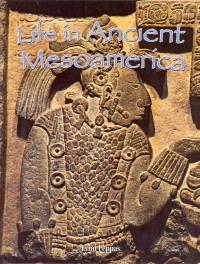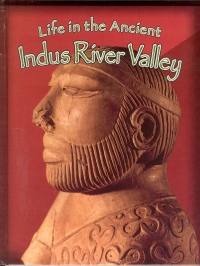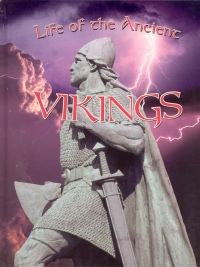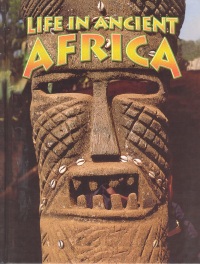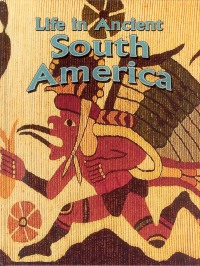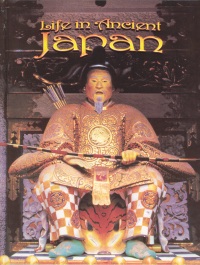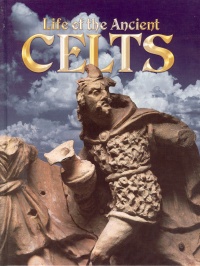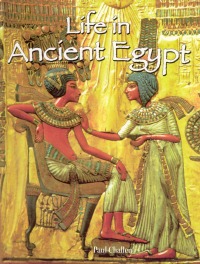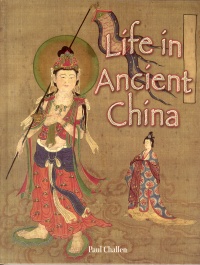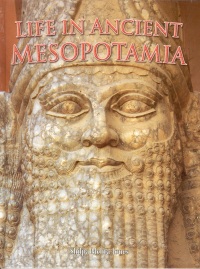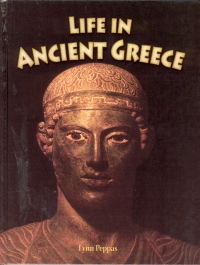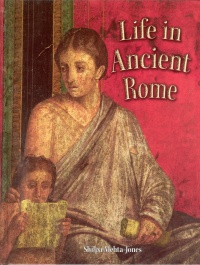| ________________
CM . . .
. Volume XII Number 1 . . . .September 2, 2005
excerpt:
According to historians, a civilization is "a group of people that shares common languages, some form of writing, advanced technology and science, and systems of government and religion." (Life in Ancient Mesoamerica, p. 5) "The People of the Ancient World" series examines a variety of civilizations, their rise and fall, and their contributions to the world. All of the books, averaging 12 chapters each, follow the same format and include information about each civilization's origins, geographical location, social structure, lifestyle, homes, clothing, food, economy, education, celebrations and art. Women's roles, the development of a written language, medicine and religion are other topics covered. The text is well written, sparking the reader's interest and sustaining it throughout. Fantastic colour photographs, maps, diagrams and illustrations, all suitably labeled, not only enhance the text, but also add visual appeal. Borders, in keeping with each book's theme, unify the series. For example, Mayan glyphs form the borders of the title on Mesoamerica, while borders of runes, bamboo stalks or pagodas appear in the titles on Vikings, China and Japan, respectively. A table of contents, a time line, an index and a glossary are also provided. Life in Ancient Mesoamerica features the Olmec, Mayan and Aztec peoples who settled in the area between North and South America. These early peoples adapted their farming methods to suit the rainforest and their marshy surroundings and traded produce for building materials and other goods. The Mayans developed a kingdom of 50 or more city-states, each with a large urban center surrounded by farming communities. They are credited with the development of glyphs, an alphabet and folding-screen books, but their greatest contributions, perhaps, lie in the fields of mathematics, physics and astronomy. Their calendar and temples, which they designed to showcase the movements of the sun, are legendary. In the area which is now Pakistan, where the river empties into the Arabian Sea, is the Indus River Valley, whose earliest inhabitants were the Harappans. Life in the Ancient Indus River Valley focuses on the Harappans, whose homes were equipped with plumbing and sewage systems, and the Aryans, whose culture eventually spread south into the Ganges River Valley, creating India's ancient civilization, and whose blending of beliefs of other cultures developed into the Hindu religion. Inventions introduced by these ancient peoples include wells, underground drains, standard measures for bricks and roads, bronze tools, such as the circular saw and the drill, the decimal system, cataract and plastic surgery, chess, playing cards and cotton thread. The Vikings, fierce warriors, are the subjects of Life of the Ancient Vikings. Considered to be the greatest explorers and traders of their time, they founded many major cities, such as Dublin, Kiev and Sicily, and discovered Greenland and Iceland. Viking society was strictly organized and ranged from kings and chieftains at the top of the hierarchy to slaves at the bottom. Known for their unique sailing ships, their belief in Norse gods and goddesses, and the development of runes carved on wooden tablets, the Vikings opened many trade routes and established major trade centers during their reign. Africa is considered to be the birthplace of the earliest humans on Earth, and, as such, is home to the world's oldest and most powerful civilizations. Life in Ancient Africa features the different areas of land and their natural resources as well as the various kingdoms and their leaders. This title compares the lifestyle of the Nubians, Aksumites and Ghanians. At that time, salt, gold and ivory were the most valuable items for trade. Camel caravans of up to 100 animals enabled goods to be transported across the vast Sahara Desert. The Nubians developed the smelting industry, which produced iron and the gold used in ceremonial masks, while the people of Benin worked in bronze, and the West Africans made iron into steel. These groups also established schools and universities and developed several languages and written scripts. Some of their written communication took the form of hieroglyphs for inscribing on monuments, while cursive writing was used on papyrus. Life in Ancient South America highlights a number of Andean groups, but particularly the most enduring among them, the Incas, who ruled more than 10 million people. The ancient Andeans domesticated the llama around 100 B.C. for transporting goods along the steep mountains paths and used its wool for clothing and blankets. They also recorded important information, such as the number of births and deaths, the amount of taxes paid and the amount of grain grown by means of a quipu. It employed a system of knots and different coloured strings to symbolize the data collected. Andean craftspeople were known for their pottery, metalwork, ceremonial masks, gold statues, weaving, stonework and pyramids. From the Ainu to the Samurai, Life in Ancient Japan highlights the clan system in which all clans were ruler by an emperor. This title discusses the influence of other trading nations, such as Persia, India, China and Korea, on Japanese culture, one example being the styles of writing adapted from the Chinese. Other topics include the importance of rice to Japan's economy—it was used a money for over 1000 years—and the national road networks used for trade, many of which have survived to the present day. Art forms, such as the tea ceremony, origami, noh theater, paper making, flower arranging and the yamato-e style of painting landscapes on screens, are all unique contributions of the early Japanese people. Ancient traditions—samurai fighting techniques, sumo wrestling, geishas, herbal medicines, shiatsu massage—are other developments. The dominant civilization in Europe from 600 B.C. to 50 B.C. consisted of the Celts, great warriors and inventors of chain metal, iron horseshoes and enameling for decoration of weapons, bowls and jewelry. Life of the Ancient Celts describes the group's agriculture-based economy and its development of ironwork and salt mining. Readers will learn about he druids, spiritual leaders who not only served as teachers and keepers of history and stories, but also claimed that they were able to predict the future. One of the oldest civilizations in history, the early Egyptians were famous for their hieroglyphs, irrigation techniques, the mummification of the dead, and their great monuments, the pyramids. In Life in Ancient Egypt, there is information about the importance of the Nile River throughout Egypt's history and the three main kingdoms, each ruled by a dynasty. A double-page spread, complete with numbered diagrams, explains the mummification process. Some of the many contributions of the Egyptians are leatherwork, cabinets and chairs, pottery, weaving, paper making and gold bracelets and necklaces encrusted with jewels. Life in Ancient China describes the ruling dynasties of the time, the development of Confucianism, Buddhism and Taoism, and the need to establish a common currency to make trade easier throughout the country. Kung fu, first practiced in China, formed the basis for karate in Japan and taekwondo in Korea. Inventors of paper, printing and the abacus, the ancient Chinese also introduced the Chinese zodiac, calligraphy, brush painting, and terra cotta to the world. Perhaps their greatest legacy is the Great Wall. Several of their inventions are still used today—gunpowder, fireworks, silk, the magnetic compass, the wheelbarrow and the stirrup. In what is modern day Iraq lived the Sumerians, Akkadians, Assyrians and the Babylonians. Life in Ancient Mesopotamia features these groups who were the earliest known users of the wheel. They started the concept of the 12-month calendar and the 7-day week and invented some of the earliest known musical instruments, including the harp and the lyre, sheet music carved onto clay tablets, and made pottery, hammered metalwork and statues with shells as inlay. The ancient Greek civilization flourished from 1800 B.C. to 150 B.C. It created a new form of government called a democracy and brought the Olympic Games to the rest of the world. These and other contributions are featured in Life in Ancient Greece. Best known for their philosophy, myths and methods of mathematics invented by Pythagoras, the ancient Greeks were also famous for their pottery, frescoes, sculptures, architecture, drama and poetry, as well as the invention of the boat anchor, the catapult and Archimedes' screw, a cylindrical device used for irrigation. The English language consists of many words which are derivatives of Latin, first used by the Romans. Life in Ancient Rome highlights the rulers and the military power of the time as well as the spread of Christianity following a tumultuous 200-year period during which the Romans tortured and killed Christians. Contributions of this ancient civilization include the 12-month Julian calendar, a water supply system for cities, central heating, glass windows and sports arenas with tickets to the events and numbered seating. Sculptures, mosaics, roads, aqueducts, temples and bath houses were other contributions, many of which are still standing today. An excellent series, well worth purchasing for school and public libraries. Highly Recommended. Gail Hamilton is a teacher-librarian in Bird's Hill School in East St. Paul, MB.
To comment
on this title or this review, send mail to cm@umanitoba.ca.
Copyright © the Manitoba Library Association. Reproduction for personal
use is permitted only if this copyright notice is maintained. Any
other reproduction is prohibited without permission.
NEXT REVIEW |
TABLE OF CONTENTS FOR THIS ISSUE
- September 2, 2005.
AUTHORS |
TITLES |
MEDIA REVIEWS |
PROFILES |
BACK ISSUES |
SEARCH |
CMARCHIVE |
HOME |
